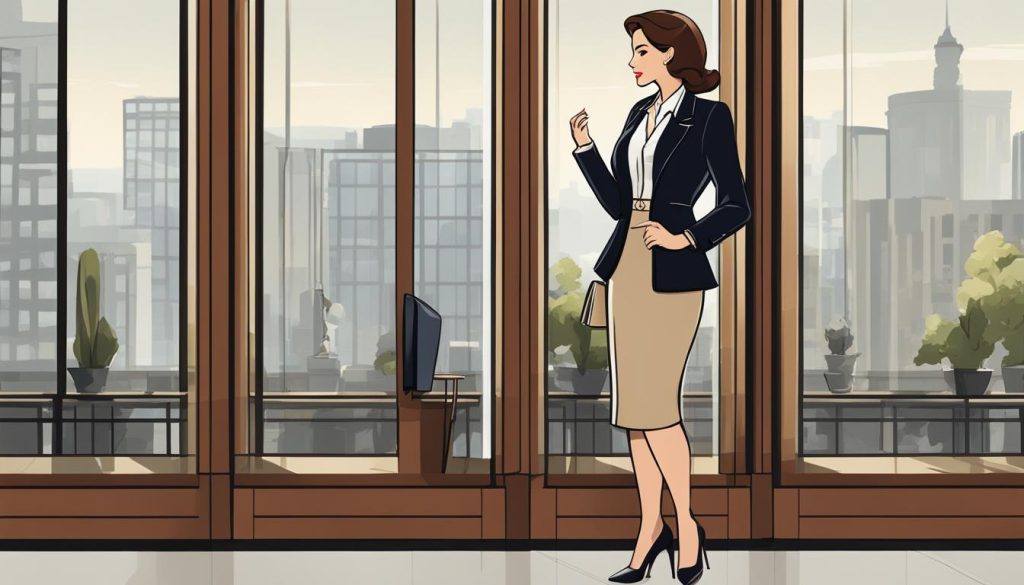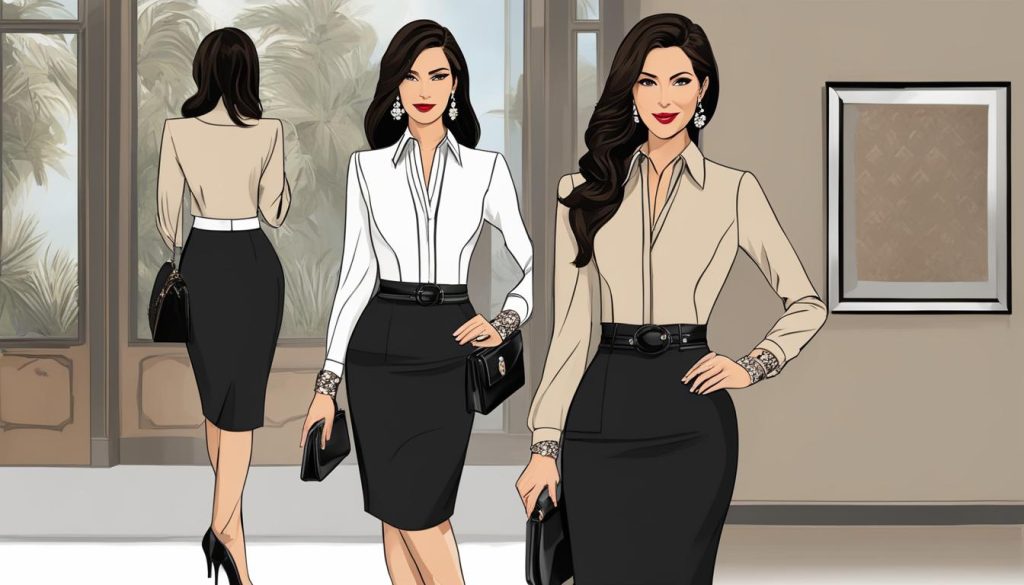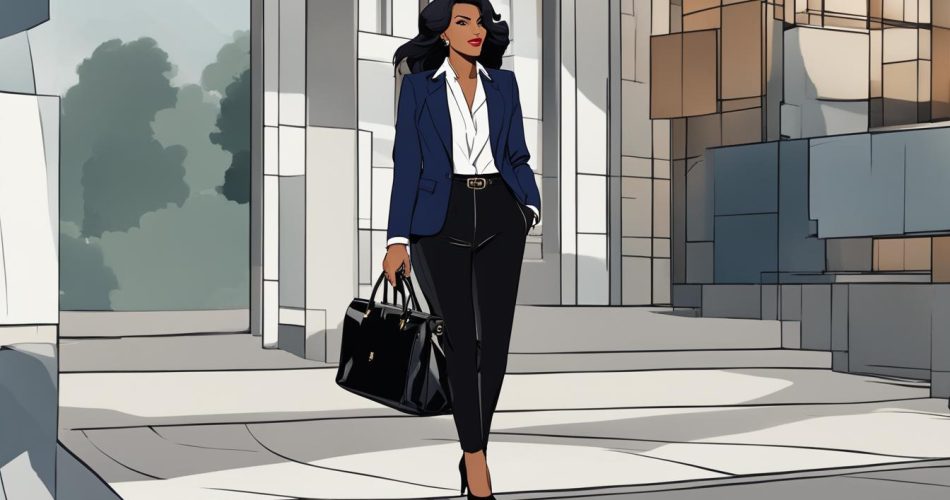The concept of business casual has become increasingly relevant in today’s workplace. As professionals, we want to dress in a way that balances style, comfort, and professionalism. In this article, I will share my top tips for navigating the business casual dress code, providing you with guidance on how to dress appropriately for the office while expressing your personal style.
Whether you’re new to the world of business casual or looking to refresh your wardrobe, this article will provide you with helpful insights and practical advice. From understanding the guidelines of the business casual dress code to exploring outfit ideas for different occasions, I’ve got you covered.
Key Takeaways:
- Dressing business casual requires finding a balance between authenticity and professionalism.
- Consider the expectations of your workplace and industry when choosing your attire.
- Opt for clothing that is both comfortable and appropriate for your career.
- Express your personal style while still maintaining a professional appearance.
- Adapt to different work environments, taking into account industry-specific variations and company culture.
The Importance of Dressing for Success
Studies have shown that how you dress can have a significant impact on your perception of yourself and your overall performance. Dressing in professional attire not only enhances your external image but also influences your internal mindset. When you dress in a more polished and professional manner, you tend to feel more powerful, confident, and capable.
Furthermore, your choice of attire plays a crucial role in how others perceive you and your credibility. When you present yourself in a professional manner, you convey a sense of professionalism and competence to others. This, in turn, can positively influence their perception of your work ethic and abilities.
“Dressing professionally not only exemplifies my dedication to my work, but it also allows me to represent my company in the best possible light. It shows that I take my role seriously and am committed to upholding the standards and values of the organization.”
Making a good impression goes beyond just your qualifications and skills. Your appearance is an integral part of your overall professional image and contributes to the impression you make on others. Dressing for success demonstrates that you value your role, take pride in your work, and prioritize professionalism.
Remember, when you dress professionally, you are not only representing yourself but also your company. Your attire sends a message about your organization’s culture and standards. By dressing appropriately, you contribute to the positive reputation and perception of your company.
So, take the time to carefully consider your professional attire. Dressing for success is not just about following a set of rules; it is about presenting yourself in a way that aligns with your goals, values, and the expectations of your workplace.
Next, we will explore what exactly business casual means and how to navigate this dress code effectively.
Dressing Professionally: How It Impacts Your Performance
- Dressing professionally enhances your self-perception and confidence.
- It boosts your credibility and professionalism in the eyes of others.
- Making a good impression contributes to a positive company representation.
- Professional attire aligns with your goals and workplace expectations.
What Does Business Casual Mean?
Business casual is a dress code that combines elements of traditional business attire with a more relaxed and comfortable style. It emerged as a response to changing work environments and focuses on flexibility and creativity. The exact definition of business casual can vary depending on the company, industry, and even the region. It is generally seen as less formal than traditional business attire, but still professional and polished. Different industries may have different interpretations of business casual, and it’s important to consider the expectations of your specific workplace.
When dressing business casual, it’s important to strike a balance between professional and relaxed. The relaxed dress code allows for more comfort and freedom in your outfit choices, while still maintaining a level of professionalism. The traditional business attire, such as suits and formal dresses, are not required in a business casual setting.
Business casual attire can vary depending on the industry you work in. For example, in more creative fields like advertising or tech startups, the dress code can be more casual, allowing for jeans and t-shirts. In contrast, industries like finance or law may have a more conservative interpretation of business casual, requiring dress pants or skirts with blouses or collared shirts. It’s important to understand the specific expectations and standards of your industry when dressing business casual.
One key aspect of business casual is the concept of “smart casual,” which often overlaps with business casual. Smart casual refers to a polished yet relaxed style that can be appropriate for various professional settings. It combines elements of both formal and casual attire, creating a refined and put-together look. This can include pairing dress pants or skirts with a blouse or a relaxed blazer with jeans.
| Traditional Business Attire | Business Casual Attire | Casual Attire |
|---|---|---|
| Suit (with tie for men) | Dress pants or skirt with blouse or collared shirt | Jeans, t-shirts, and sneakers |
| Formal dresses | Dresses or skirts (knee-length or longer) with blouses or sweaters | Shorts, tank tops, and flip flops |
| Dress shoes | Dress shoes or loafers | Sneakers or sandals |
Overall, business casual is about finding a balance between professionalism and comfort. It allows individuals to express their personal style while still adhering to the expectations of their workplace. Dressing appropriately for different environments and industries is crucial, as it reflects your professionalism and can contribute to your success in the business world.
Tips for Dressing Business Casual

When it comes to dressing in a business casual style, finding the right balance between authenticity and audience is crucial. You want to express your personal style while still meeting the expectations of your workplace. Here are some tips to help you navigate the world of business casual attire:
Choose Appropriate Clothing
When selecting your business casual wardrobe, consider the level of formality required for different situations. Dress slightly more formally for client meetings or important presentations, and opt for a slightly more relaxed look for team meetings or casual Fridays. It’s essential to choose clothing that is professional and polished, avoiding items that are too casual or revealing.
Comfort and Career
While it’s important to look presentable, don’t forget to prioritize your comfort. Consider the demands of your job and choose clothing that allows you to move comfortably throughout the day. Opt for fabrics that are breathable and flexible, ensuring that you can feel confident and at ease while performing your tasks.
Fashion and Culture Fit
Expressing your personal style is a great way to stand out, but it’s also crucial to fit in with the culture of your workplace. Take some time to observe the fashion choices of your colleagues and higher-ups to get a sense of what is considered appropriate. Strive to find a balance between your authentic style and the expectations of your workplace, creating an outfit that speaks to both.
Remember, dressing business casual is all about looking professional and put-together while incorporating a touch of personal style.
Dos and Don’ts of Business Casual Attire
Here are a few dos and don’ts to keep in mind when it comes to business casual attire:
- Do opt for tailored clothing that fits well and flatters your body shape.
- Don’t wear clothing that is too casual, such as jeans, sneakers, or T-shirts.
- Do choose appropriate footwear, such as dress shoes or polished flats.
- Don’t wear clothing that is revealing or excessively tight.
- Do accessorize with simple and understated jewelry.
- Don’t wear excessive or distracting accessories.
| Do | Don’t |
|---|---|
| Opt for tailored clothing | Wear jeans, sneakers, or T-shirts |
| Choose appropriate footwear | Wear revealing or excessively tight clothing |
| Accessorize with simple jewelry | Wear excessive or distracting accessories |
By following these tips and guidelines, you can confidently navigate the world of business casual attire, ensuring that you strike the perfect balance between professionalism and personal style.
Business Casual Outfit Ideas

When it comes to dressing business casual, there are plenty of outfit ideas that can help you strike the perfect balance between professionalism and style. Whether you’re a woman or a man, it’s essential to choose appropriate attire based on the occasion and event you’re attending. Let’s explore some outfit ideas that can guide you in creating a fashionable yet professional look.
Women’s Business Casual Outfit Ideas:
For women, there are several options to consider for a business casual look. Here are some ideas:
- Pair a knee-length skirt or dress pants with a blouse or sweater for a polished and comfortable look.
- Opt for a knee-length or maxi dress for a more feminine and elegant approach.
- Combine dark-wash jeans with a tailored blazer and a blouse for a chic and modern outfit.
Remember, it’s important to dress slightly more formally for client meetings to maintain a professional appearance. However, for team meetings or office parties, you can add some casual elements while still looking polished.
Men’s Business Casual Outfit Ideas:
If you’re a man, here are some outfit ideas to help you navigate the business casual dress code:
- Wear dress slacks or chinos paired with a button-down shirt or sweater for a classic and sophisticated look.
- Combine dark jeans with a blazer or sports coat for a more relaxed yet polished appearance.
- Opt for a dress shirt with a tie for client meetings, and loosen up the dress code with a more casual shirt for team meetings or office parties.
By choosing appropriate attire based on the nature of the event or meeting, both women and men can create stylish business casual outfits that align with professional expectations.
It’s important to note that these outfit ideas are just suggestions, and you can always adapt them to your personal style and preferences. The key is to find a balance between comfort, fashion, and the culture fit of your workplace.
Appropriate Attire for Different Occasions
| Occasion | Women | Men |
|---|---|---|
| Client Meetings | Pair a tailored skirt or dress pants with a blouse or sweater. | Wear dress slacks or chinos with a button-down shirt and tie. |
| Team Meetings | Opt for a more casual dress or a combination of jeans and a blazer. | Wear dark jeans with a blazer or a more relaxed shirt. |
| Office Parties | Dress up in a knee-length or maxi dress or add accessories to a casual outfit. | Choose a more casual shirt or add layers to a smart casual look. |
Business Casual Dress Code Variations
The dress code for business casual can vary depending on industry-specific variations, company culture, seasonal variations, modern interpretations and trends, and adapting to different work environments. Understanding these variations is crucial for successfully navigating the business casual dress code and maintaining a professional appearance in the workplace.
Industry-Specific Variations
Different industries have their own expectations and norms when it comes to business casual attire. It’s important to consider the industry you work in and align your outfit with its specific requirements. For example, the dress code for a creative industry like advertising or fashion may be more relaxed and allow for trendy and expressive clothing choices, while a formal industry like banking or law may require a more conservative and traditional approach to business casual attire.
Company Culture
Company culture also plays a significant role in determining the appropriate dress code. Some companies have a more laid-back and casual culture, where employees have more freedom in their clothing choices and can embrace modern interpretations and trends of business casual. On the other hand, other companies may have a more formal culture that requires employees to adhere to a stricter dress code, even when it comes to business casual attire.
Seasonal Variations
The seasons can also influence what is considered appropriate for business casual dress. In warmer months, lighter fabrics and breathable clothing can be more comfortable and suitable, while in colder months, layering options and warmer fabrics are necessary. Adapting your business casual attire to the seasonal variations ensures that you stay comfortable while still looking professional.
Modern Interpretations and Trends
Modern interpretations and trends can impact the business casual dress code, and it’s important to stay aware of these changes. However, it’s essential to consider whether these trends are appropriate for your specific workplace. While it’s great to incorporate modern elements into your outfits, it’s crucial to maintain a polished and professional appearance that aligns with your company’s expectations.
Adapting to Different Work Environments
Lastly, adapting to different work environments is key when it comes to business casual attire. Whether you are attending a client meeting, a team meeting, or an office party, it’s essential to dress appropriately for the occasion while still maintaining a professional image. Understanding the expectations of each work environment and adjusting your outfit accordingly will ensure that you make a positive impression and fit in seamlessly.
| Industry | Business Casual Norms |
|---|---|
| Marketing | Trendy and expressive clothing choices allowed |
| Finance | Conservative and traditional approach required |
| Tech | Casual and relaxed attire accepted |
| Law | Meticulously polished and formal dress code |
Conclusion
Dressing business casual is all about finding the perfect balance between professionalism and comfort. It’s crucial to consider the expectations of your workplace while still expressing your personal style. Keep in mind that there are some general guidelines to follow when it comes to business casual attire. Avoid clothing that is overly casual or revealing, and instead, opt for polished and professional pieces.
However, it’s important to note that the dress code for business casual can vary depending on your industry, company culture, and even the season. Adapting to different work environments is essential. Take the time to understand the expectations of your specific workplace and align your outfit accordingly.
By finding that sweet spot between being professional and comfortable, you can create a polished appearance that is appropriate for your workplace. Remember to always prioritize finding that balance, follow the tips for dressing business casual, and adapt to different work environments to ensure that you make a positive impression with your attire.
FAQ
What is business casual?
Business casual is a dress code that combines elements of traditional business attire with a more relaxed and comfortable style. It is generally seen as less formal than traditional business attire, but still professional and polished.
Why is dressing for success important?
Dressing for success is important because it can impact your perception of yourself and how others perceive you. Your appearance can also reflect your professionalism and make a good impression on others.
How should I balance my authenticity and professionalism when dressing business casual?
When dressing business casual, it’s important to consider the expectations of your workplace while still expressing your personal style. Strive to find a balance between fitting in with the culture of your workplace and being true to yourself.
What are some dos and don’ts of dressing business casual?
Dos: choose polished and professional pieces, opt for clothing that is neither too casual nor revealing, and dress slightly more formally for client meetings. Don’ts: wear clothing that is too casual or revealing, and dress inappropriately for the occasion or workplace.
What are some outfit ideas for dressing business casual?
For women, options can include pairing skirts or dress pants with blouses or sweaters, or opting for knee-length or maxi dresses. For men, dress slacks or chinos with button-down shirts or sweaters are appropriate. It’s important to consider the nature of the event or meeting when choosing your outfit.
Are there variations in the business casual dress code?
Yes, the business casual dress code can vary depending on the industry, company culture, and season. Different industries may have different expectations, while company culture and seasonal variations can also influence what is considered appropriate.
What should I keep in mind when adapting to different work environments?
When adapting to different work environments, consider the expectations of your specific workplace, industry, and company culture. Strive to create a professional and polished appearance that is appropriate for the specific context.

